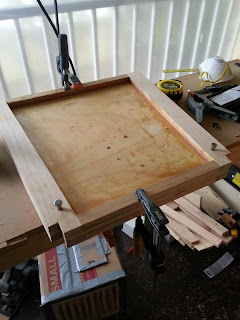Still going slowly, lots of little things and prep work getting done before hulls are assembled...soon now.
I know that one day I'd like to extend the wa'apa out to 24 feet by building the middle hull section. I also realize that after the two sections I'm working on now are assembled and finished, it will probably be quite difficult to make more #2 bulkheads for the middle section that are identical to the current ones..bolt holes and all. With that in mind I decided to make a #2 bulkhead template from my current ones that I can use at a later time for building the middle section.
 |
| Scrap ply clamped under current #2 bulkhead and bolt holes transferred through. |
 |
| With bolt holes transferred and bulkhead traced. |
 |
| All cut and planed to match. |
I then got the chines glued on to the side panels.
 |
| Drywall screws through pieces of scrap ply used to hold chines while glues cures. Note the use of packing tape between, important if you don't want that scrap ply to become permanently attached. |
And then the inside faces of the side panels got three coats of epoxy, wet on wet. Figured would be easier to coat and sand flat on the table, rather than later after assembly.
 |
| Three coats of epoxy, areas taped off where bulkheads and such will be glued later. |
Next up will be getting the gunwales ripped and glued on, along with floor supports. Then some more sanding the epoxy back..fun fun..and the side panes should be done and ready for assembly.































